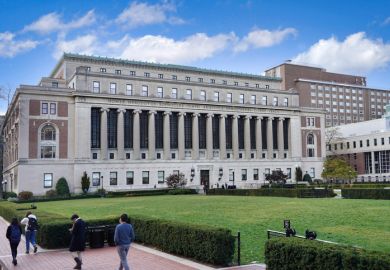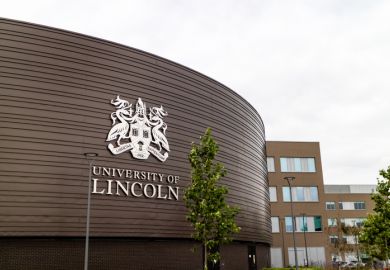Source: Alamy
Work in progress: the decline in part-time student numbers has ‘implications for equality and diversity’
Problems requiring “immediate attention” are emerging under the new fees and funding system, including a “dramatic decline” in the number of part-time entrants that could potentially reduce access for poorer students, England’s funding council has warned.
A report by the Higher Education Funding Council for England on the impact of the system, published on 14 March, also highlights “wide variation in the financial performance and health” of institutions.
Perhaps surprisingly, 11 higher education institutions and 14 further education colleges recruited so strongly that they exceeded their limits on student numbers this year, Hefce says.
This was despite a 12 per cent (or 47,000) drop in the number of full-time home and EU undergraduates entering the English sector.
In its conclusion, Hefce appears to make a veiled criticism of the government’s changes, saying that “rapid changes in policy can lead to unpredictable outcomes”.
On the impact of higher fees, Hefce says it is “impossible to separate short-term volatility from long-term trend”, with demographic and economic changes being other possible factors behind falling student demand in 2012-13.
It also says figures that show plateauing demand in Scotland in 2011-12 suggest that the same thing might have happened in England “even if fees had not risen”.
Nevertheless, it warns that “a number of important issues are already emerging which require immediate attention”.
The Hefce report is titled Higher Education in England: Impact of the 2012 Reforms.
It is a revised version of a report commissioned by the Department for Business, Innovation and Skills, delivered to the department in December. However, Hefce and BIS have suppressed the full version.
Sir Alan Langlands, Hefce’s chief executive, rejected a Freedom of Information request from Times Higher Education to release the full report. In the refusal letter, he says that doing so would “curtail the dialogue we are currently having with BIS”, suggesting that the report could bring about policy change.
“Having expressed our advice and views frankly in the December report we are now in a position where we can explore different approaches and assist BIS as it considers whether or not to pursue a particular course,” Sir Alan writes.
Access threat
The report states that the number of part-time undergraduates and taught postgraduates entering higher education fell 26.6 per cent to 221,000 in 2012-13 (37 per cent down on 2010-11 levels).
The funding council warns: “Decreases in the part-time student population, which includes larger numbers of non-traditional students, are likely to have implications for equality and diversity.”
Part-time undergraduates became eligible for fee loans of up to £6,750 a year as part of the 2012-13 fee rises, a policy that was trumpeted by the coalition as a huge boost for widening participation.
David Willetts, the universities and science minister, revealed last week - in answer to a written parliamentary question from his Labour shadow, Shabana Mahmood - that just 31,700 part-time undergraduates had applied for loans and been judged eligible in 2012-13. Hefce gives a figure of 154,000 for total part-time undergraduate entrants.
Of the reforms’ impact across subjects, Hefce says that science, technology, engineering and mathematics have generally fared better than the arts, humanities and social sciences.
It adds: “Modern foreign languages saw the greatest proportional drop in entrants in 2012-13, of 14 per cent.”
On institutions’ varying fortunes, it says that “there appears to be no particular approach adopted…that has led to some doing better or worse than others”.
However, it is likely that varied responses in “educational programmes, approaches to marketing, and offer and admissions strategies…have contributed to different recruitment outcomes”.
The funding council warns that “the decline in collaborative activity to deliver outreach”, plus changes in the school sector and the abolition of the Education Maintenance Allowance, “may impact on widening participation”.
In a statement to THE, Sir Alan says it is “difficult to draw firm conclusions at this early stage of the reforms”.
He continues: “But today’s report also highlights some causes for concern: in particular, sharp drops in recruitment to part-time courses and a related decline in mature entrants.
“And although recent positive trends in widening participation appear to have been sustained in the first year of the reforms, disparities in the recruitment and retention of students by social background and gender remain unacceptably stark.”
Comment: Sir Alan Langlands
Higher education is one of England’s great success stories. It transforms lives, and brings enormous economic, social and cultural benefits. Many universities and colleges are world-class, and despite recent negative media coverage, the country remains a popular destination for international students.
Last year’s introduction of higher fees and new funding arrangements, with the majority of undergraduate funding now following the student, significantly changes the rules of the game. This is true not only for universities and colleges but also for students, many of whom have faced a near trebling of tuition fee loans - although we must not forget that they do not have to pay upfront and that their repayments will never exceed their ability to pay.
The report we have published today, Higher Education in England: Impact of the 2012 Reforms, charts the impact of these and wider changes.
Much discussion has focused on full-time undergraduate recruitment. Both 2011 and 2012 were atypical - 2011 because of the deterrent effect of the coming higher fees on deferrals, and 2012 because of the knock-on effects of those decisions and the impact of the new fees themselves. Numbers of young entrants in 2012 decreased compared to 2010, but look set to recover in 2013 if applications carry through into acceptances and enrolments. We can therefore feel reasonably confident that the reforms have not - or not yet - led to the major declines in full-time numbers that some predicted.
Recent positive trends in widening participation for students from less advantaged groups have also held up. However, the overall figures remain stark. According to the Universities and Colleges Admissions Service, 18-year-olds from the most advantaged areas are still three times more likely to apply to university than those from the most disadvantaged areas. Entry rates for more selective universities are typically six to nine times higher for those from advantaged areas. And 18-year-old women are a third more likely to apply than 18 year-old-men, rising to 50 per cent more likely in more deprived areas. These facts cannot be ignored.
Nor can the fact that part-time study continues to decline dramatically, with undergraduate entrants down by 105,000 - 40 per cent - since 2010. There are signs that some employers and potential students may not fully understand the new system, or are questioning the value they will get from the increased investment. Given the importance of part-time students to widening participation, it will be crucial to address this issue. On the upside, it may provide a spur to the development of more innovative, flexible and affordable approaches to learning, including but not limited to blended learning with a strong online element.
There has been widespread speculation about the impact of the reforms on postgraduate provision. We do not yet know whether increased undergraduate loan commitments will make students more reluctant to continue their studies. Postgraduates bring vital skills and experience to higher education and to the wider economy and society. Hefce will continue its support for taught and research postgraduate provision, and keep a close eye on any emerging trends.
We will also continue to monitor changes in student demand for particular subjects and subject groups, again providing support where needed. In broad terms, science, technology, engineering and mathematics subjects held up better in 2012 than those in the arts, humanities and social sciences, with the greatest proportional fall in undergraduate recruitment - 14 per cent - coming in modern foreign languages.
We are establishing an observatory at Hefce to ensure we have the expertise to explore and interpret the most accurate and relevant information on higher education. It will also be important to understand how wider factors, such as economic conditions and changes to school and further education policies, will play out in the medium to long term. This is one of the ways in which we will fulfil our responsibility to oversee higher education in England, and to protect and promote the student and public interest.
Finally, the sector is currently in reasonable financial health, with sound surplus levels, good cash balances and healthy reserves. However, there is wide variation in the financial performance and health of different institutions, and some will face difficulties if they experience repeated falls in student recruitment. We suggest that it will be important to keep the balance of public and private investment under review to ensure that higher education maintains its excellence and competitive edge.
There are certainly challenges ahead, but there are also significant opportunities. As the funding reforms bed down, English higher education remains capable of going from strength to strength.
Sir Alan Langlands is chief executive of the Higher Education Funding Council for England
Register to continue
Why register?
- Registration is free and only takes a moment
- Once registered, you can read 3 articles a month
- Sign up for our newsletter
Subscribe
Or subscribe for unlimited access to:
- Unlimited access to news, views, insights & reviews
- Digital editions
- Digital access to THE’s university and college rankings analysis
Already registered or a current subscriber? Login




